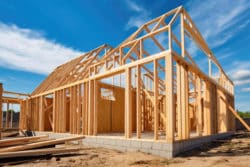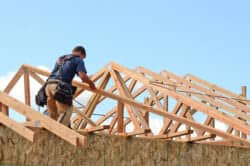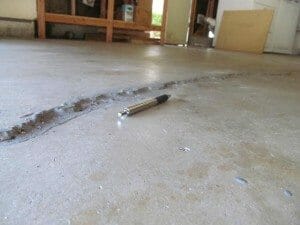Drywall Cracks at Door and Window Corners – Causes and When Serious
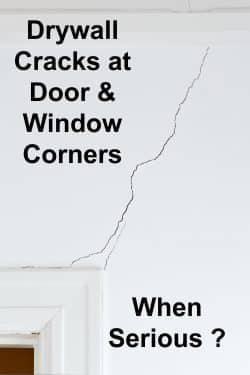
Drywall cracks at window and door corners are not unusual but can be a warning sign of structural issues with the framing, foundation or moisture issues. Recognizing early on which cracks are serious will allow you time to make corrections before costly damage occurs to the home.
One of the most common reasons for drywall cracks at door and window corners is that these corner areas generally have much more stress on them than most other drywall areas. What’s important, is what the causes of the cracks are and if they’re relate to structural issues, for if so, corrective action may need to be taken before the issue worsens.
Fortunately, the majority of the reasons for these cracks are not serious structural issues.
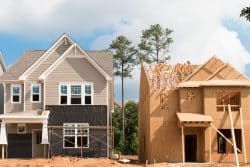
First, a note about new homes with drywall cracks
Note, drywall cracks in new homes, under two years old, may need to be analyzed a little differently than those in older homes.
When questions arise about drywall cracks in a home, one of the first questions engineers may ask; “how old is the home? Is it less than a year or two old? If the home is a newer home, then the causes may relate to common issues which often occur in new homes, such as a small amount of foundation settlement and wood shrinkage. Add to this, the normal humidity issues being amplified due to concrete curing, drywall compound setting up and new paint releasing moisture in the air; all of which can contribute to drywall cracking in new homes.
Five common causes of cracks at window and door corners
Engineers and contractors know that there are many reasons for cracks at door and window corners. Most of the reasons fall into five categories.
Causes of cracks
- Framing issues
- Humidity & temperature fluctuations, as well as, plumbing or roof leaks
- Seasonal causes
- Poor workmanship and improper materials
- Structural issues – foundation and soil movement
Remember – rule out the obvious or unusual
When wondering about drywall cracks, don’t forget to rule out some of the causes that you hadn’t thought about or had forgotten. These include something that had placed a heavy stress on the homes’ framing or foundation, things like an earthquake, a land slide nearby, a tornado or hurricane. If you live in an area that has underground mining or a subway has been built under or near your home, then there may be soil movement or foundation issues. These types of causes are rare, but if your cracks appeared around some of these events or conditions, then more attention should be given to these items and the cracks.
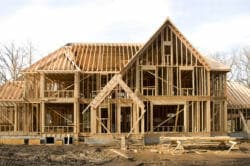
1. Framing Issues
Movement of the framing around windows and doors
Any movement of the framing around a window or at a door will put additional stress on the drywall, thus cracks will often appear at these corner areas or near the corner areas; either at a taped joint where two pieces of drywall abut one another or the crack will run through the drywall itself, usually at an angle of some sort.
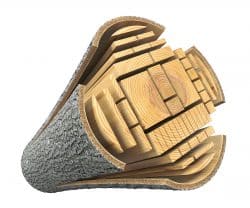
Lumber
- It normally will shrink when it dries
- Expands when it absorbs moisture
- Often will twist, bow and cup when it dries over time
Headers over doors and windows and wood shrinkage problems
Doors and windows generally have a “header” over them. A header is a horizontal structural framing member that carries the weight or supports the load above the door or window opening. Wood headers in residential homes, especially older ones, are often sawn dimensional lumber, such as a 4 x 6 or a 6 x 12 header. Note, the size and material of a header is usually called out by an engineer and/or code. If not standard dimensional lumber, then engineered wood headers, like structural composite lumber (SCL) or laminated veneer lumber (LVL) / (Glulam) are used.
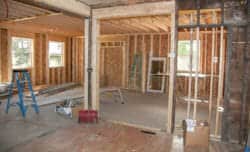
If dimensional lumber is used rather than composite lumber, then there may be a problem with wood shrinkage issues dealing with the moisture content of the lumber. If the drywall is fastened to the dimensional lumber header, especially if it has a high moisture content and it is also fasten to the studs at the end of the header, then as the header loses moisture content, it will shrink and this shrinkage will cause cracks at the corners of doors or windows. This is more prevalent in new homes than older homes. (Read about the problems with wood shrinkage, especially structural issues and mold and mildew)
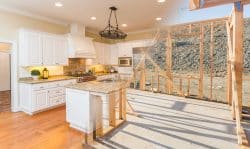
Remodeling
Remodeling changes, such as, adding or enlarging doors or windows, relocating or modifying doors and windows may result in cracks at some of the door and window corners; for there may be different stress points and at times shrinkage of the new framing lumber.
Failure to follow the building code for framing in doors and windows
If a DIY homeowner or a non-professional framed the door and window openings, they may not have known the building code when it comes to the framing requirements involving headers, jack studs, king studs, cripples, rough sills, lumber grades, moisture content restrictions and nailing requirements; just to name a few. Framers who use lumber that exceeds the moisture content limitations by code can lead to excessive wood shrinkage and possibly mold and mildew developing in the walls.

2. Humidity, temperature & leaks
Humidity and temperature may cause or contribute to drywall cracks, including those at door and window corners. Small changes in temperature or humidity will usually not have any significant effect on drywall. Larger differences can affect drywall and wood framing.

As we know, when something heats up, it expands and when it cools down, it shrinks. This is one of the reasons engineers recommend that if a wall is over 30 feet long, that there should be expansion joints. This helps reduce cracking.
When humidity is on the high side, wood and drywall tends to absorb the moisture in the air and when the humidity level is very low, it generally loses moisture. This likewise may lead to cracking. In order to reduce some of the cracking homeowners will have a dehumidifier in their home to remove moisture out of the air. (If you wish, check prices and features of dehumidifiers)
Truss uplift may contribute to drywall cracks
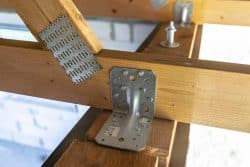
Truss uplift is a good example of how humidity and temperature can cause cracks in drywall. It usually causes cracking on interior walls, not exterior walls and sometimes contributes to the cracking at door corners on interior walls. These cracks are usually on the walls where the trusses run perpendicular to where a wall meets the ceiling. If there are doors located in the walls where truss lift occurs, then it is not uncommon for there to be cracks near or at the door corners, however, the majority of cracks caused by truss uplift are where the walls meet the ceiling.
From a structural standpoint, the trusses’ bottom cord lifts up from the top plate of the framed wall and when this happens a crack will appear where the wall meets the ceiling, especially if the framing and drywall was not installed properly to resist this from occurring. (Read more about truss uplift and it’s causes)
Leaks
Window, roof and plumbing leaks are not uncommon for homeowners to experience, however, moisture can weaken drywall, depending on the amount of moisture and for how long the drywall is exposed to it. Weakened drywall cracks easier than sound drywall, therefore, if there are any moisture type stains or mold and mildew evidence visible at window or door corners and there is a crack; then moisture may be the cause.
Remember to look carefully at the edges of any visible drywall tape for stains or moisture evidence. Push on it for solidness and if you have a moisture meter, check the moisture content of the drywall, for it may reveal that there is a high moisture level that is not visible to the naked eye.

3. Seasonal issues
Surprisingly, seasonal changes rank in the top 5 causes of drywall cracks. One indication that seasonal changes may be causing drywall cracks in your home is when the cracks open up in some seasons and close in other seasons.
Seasonal changes that contribute to cracks:
- Temperature
- Humidity
- Rain
In the rainy season, homes built on expansive soils, which are very prevalent in parts of the country, will often have upward foundation movement. This is because when expansive soils get wet, they expand and conversely in the dry season they will shrink. This expansion and contraction of the soils often causes the foundation to move up and down due to the seasons. This may cause drywall cracks, and, in some homes, the cracks may open or close due to the seasonal changes.
Vacation homes and vacant homes
Vacation homes and vacant homes often have a higher incidence of drywall cracks caused by temperature and sometimes humidity issues than homes that are lived in full time. The reason is that they usually have a wider range in temperature and at times humidity than a home that is occupied every day. For this reason, as well as other reasons, homeowners may wish to consider controlling the temperature and humidity, even when the home is vacant.
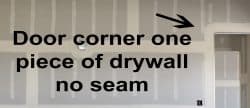
4. Poor workmanship and wrong choice of materials
Not all drywallers have the same skill levels and at times DIY homeowners may not be aware of how professionals hang, tape and mud drywall, thus not realizing that their workmanship is resulting in drywall cracks at window and door corners.
Installing drywall at door or window corners
One of the most common mistakes made in hanging drywall at door and window corners is to have a seam (where two pieces of drywall abut one another) at these corners. DIY homeowners and even some professional drywallers will do this because it’s faster and easier to cut and install.
The problem with doing this is that there’s more stress at these corners and if there is a taped joint, it will be much more likely to crack than if there was no joint. The photo shows the correct way – no joints or seams at the door corner.
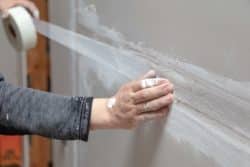
Failure to use the right type of drywall mud or tape
Note – Drywall “joint compound” is usually just called “mud” by most professional drywallers.
There are a number of types of drywall mud, such as “All Purpose,” “Light Weight All Purpose,” “Topping compound,” and quick-setting drywall mud (sometimes called “Hot” mud) as well as other types of mud. If the wrong type of mud is used for a specific condition or stage of taping in mudding the drywall, then the probability of cracking increases.

“Alligator” cracking
If drywall mud is applied too thick or has too much water added to it, it’s not uncommon to get thin cracks due to the shrinkage of the mud when it dries: what many call “alligator cracking” because it looks a little like hairline cracks in an alligators skin.
Paper tape verses mesh drywall tape
In the drywall industry many drywall contractors feel that paper tape is stronger than mesh tape and that when there is stress and movement of a structure, that the paper tape will stand up better. That there will be less problems and less cracking.
Straight hairline cracks
If there are straight thin hairline cracks running vertically (90 degrees to the floor) or horizontally (parallel to the floor) and it’s at a place where two pieces of drywall abut; then it’s often due to a faulty taping job. If so, it is easy to repair and relates to workmanship issues, not structural issues.
If there are vertical cracks at outside wall corners which are about 1-inch offset from the corner, they are likewise usually a workmanship issue dealing with the corner bead installation or a faulty taping job.
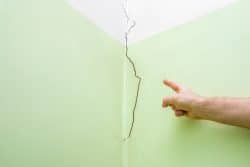
5. Drywall cracks may be a warning sign of structural issues
Most drywall cracks at door and window corners are not caused by structural issues; most are minor, cosmetic or a maintenance type of issue, however, they can occasionally be a “Yellow or Red Flag” warning sign that there are one or more structural problems. When this is the case, the sooner a homeowner addresses these types of issues or problems, the more likely the cost of correcting them will be cheaper, rather addressing them later when the cost of fixing them is much more.
Two key structural concerns revolve around soil and foundation movement, and when these occur, they can cause minor to serious damage to the homes’ framing and other components of the home; this may be partially evidenced by drywall cracks, including those at door and window corners.
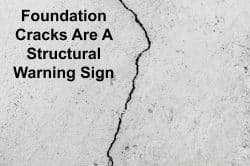
Movement of the foundation or soils – affects the framing
If a foundation shifts or moves, then the wood framing sitting on the foundation will generally move as well; often resulting in additional stress at door and window corners. Homes where there are expansive soils, settlement, slope creep and tree roots too close to a foundation may incur damage to the foundation. These types of causes often relate to or cause structural damage to a home as well. The seriousness will often depend on the amount and speed of the movement. As we know, earthquakes and landslides involve soil movement and can cause a home to have significant damage or even collapse, however, even slow soil movements over time may likewise cause serious damage.
Movement of the foundation may weaken or damage the wood framing members in a home, i.e. studs, ceiling joist, trusses, headers etc. and can result in loosen metal fasteners, nails and screws. When the metal hardware that connects various structural wood framing components together becomes loose or damaged, then there is a risk that structural connections may fail.
Cracks that are 1/8, 1/4 or 1/2 inch wide
Structural engineers are usually not too concerned about hairline cracks but will consider all cracks when evaluating the seriousness of drywall cracks; especially cracks that are a 1/8 of an inch or larger. Not only will they look at the size and location of the drywall cracks, they will look for other structural warning signs, such as cracked foundations, sloping floors, sagging roofs, etc., that may indicate structural problems.
Cracks that run from a door or window corner and continue up into the ceiling area
When a crack is wide, at an angle (i.e. a 30 or 45 degree) and continues running into the ceiling drywall sheets is usually considered a major concern. Even if a crack has only one or two of these characteristics, there is a concern and a check for other warning signs of structural issues should be made.

Drywall cracks are not unusual and generally are not a structural concern, however, when homeowners see them, they should look at the big picture – the entire structure to help determine if they are serious. The cracks may occasionally be a “Red” or “Yellow” flag that a problem is beginning to appear or that there is a serious problem. Being knowledgeable about drywall cracks and their causes can help homeowners determine the seriousness.
- Cracks that are larger than 1/8 inch are much more of a concern than hairline cracks
- Cracks that are at seams where two pieces of drywall meet are usually less of a concern than ones that are 1/16 of an inch wide, or more, and run through a sheet of drywall at an angle or meander, which may be much more serious.
- The age of the crack. If a crack has remained the same for 10 or 20 years, then it may not be a significant concern when compared to a small crack that is getting larger over a short time period or that the number of cracks is getting bigger.
- Door and window corner areas generally have more stress than other areas; thus, more cracking may occur at these areas.
- Check the outside of your home for cracks, gaps or other issues at door and window corners; especially homes’ that have stucco, brick or stone exteriors.
- When there are significant or serious cracks, it is wise to consult with a structural engineer. Especially when there’s foundation cracks, sloping floors, uneven gaps around doors (where the gap is more like a very long skinny tri-angle type of gap), or when windows or doors are sticking; then more weight should be put on the importance of the drywall cracks.

